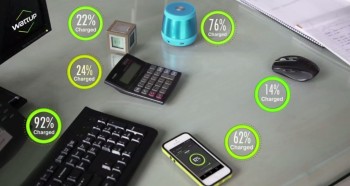
Latest Energous innovation means you could wirelessly charge your smart watch while you’re wearing it
Remember Energous? We’ve brought this company’s work to your attention a couple of times over the past year. Here’s a quick recap: they’ve found a way to commercialize wireless charging that doesn’t require contact pads.
They use a technology (named WattUp) that casts an RF signal into specific directions, and a chip captures that RF energy and converts it into the DC energy that’s needed to juice a battery up. To put it in a more natural way, it’s like charging your phone with a WiFi signal — there are no surfaces, cables or anything to have your phone up against.
While that technology still hasn’t found its way into any known commercial products, the company has continued to find ways to improve it in order to increase the amount of ways it can be used. Their latest efforts include shrinking the energy receiver component down to a size where it can fit into virtually anything while still providing enough power — 5.5 watts at 5 feet — to charge any portable consumer electronic.
They were able to get the chip down to a size of 3.3mm, which is plenty small enough for smartphones and tablets, but also just small enough to be able to wiggle its way into wearables like smart watches. Imagine being able to charge your smart watch while it’s on your wrist by simply sitting near a WattUp charger. This would be a huge solution to one of the major pain points holding smart watches back.
The problem? We still aren’t hearing any specific about who is interested in taking advantage of this stuff. Energous continues to claim they have a top 5 OEM they’re working with to implement WattUp in a forthcoming product, but we don’t know who that partner is or what type of product it will be. Our best guess is Motorola, for what it’s worth.
That makes for an interesting, but frustrating scenario: the hardest part about pioneering the technology wasn’t building it, but getting people to adopt it. We imagine those frustrations are increased ten-fold when considering it’s a technology that most people should be ecstatic to have in their lives.
Battery tech isn’t fast enough to improve, so we look for charging tech to pick up its slack (otherwise fast chargers wouldn’t have caught on as quickly as it did). It makes you wonder why any manufacturer wouldn’t try their hardest to get this stuff into their next big product. Let’s hope 2016 brings us the good news we’re hoping to hear.
[via Energous]